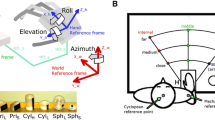Abstract
The human hand uses a combination of feedforward and feedback mechanisms to accomplish high degree of freedom in grasp control efficiently. In this study, we used a synergy-based control model to determine the effect of sensory feedback on kinematic synergies in the grasping hand. Ten subjects performed two types of grasps: one that included feedback (real) and one without feedback (memory-guided), at two different speeds (rapid and natural). Kinematic synergies were extracted from rapid real and rapid memory-guided grasps using principal component analysis. Synergies extracted from memory-guided grasps revealed greater preservation of natural inter-finger relationships than those found in corresponding synergies extracted from real grasps. Reconstruction of natural real and natural memory-guided grasps was used to test performance and generalizability of synergies. A temporal analysis of reconstruction patterns revealed the differing contribution of individual synergies in real grasps versus memory-guided grasps. Finally, the results showed that memory-guided synergies could not reconstruct real grasps as accurately as real synergies could reconstruct memory-guided grasps. These results demonstrate how visual and tactile feedback affects a closed-loop synergy-based motor control system.









Similar content being viewed by others
References
Ajiboye AB, Weir RF (2009) Muscle synergies as a predictive framework for the EMG patterns of new hand postures. J Neural Eng 6(3):036004
Bernstein N (1967) The co-ordination and regulation of movements. Pergamon-Press, Oxford, NY
Berthier NE et al (1996) Visual information and object size in the control of reaching. J Mot Behav 28(3):187–197
Cappellini G et al (2006) Motor patterns in human walking and running. J Neurophysiol 95(6):3426–3437
Cesari P, Newell KM (1999) The scaling of human grip configurations. J Exp Psychol Hum Percept Perform 25(4):927
d’Avella A, Saltiel P, Bizzi E (2003) Combinations of muscle synergies in the construction of a natural motor behavior. Nat Neurosci 6(3):300–308
Goodale MA, Jakobson LS, Keillor JM (1994) Differences in the visual control of pantomimed and natural grasping movements. Neuropsychologia 32(10):1159–1178
Hesse C, Franz VH (2009) Memory mechanisms in grasping. Neuropsychologia 47(6):1532–1545
Ingram JN et al (2008) The statistics of natural hand movements. Exp Brain Res 188(2):223–236
Jeannerod M (1984) The timing of natural prehension movements. J Mot Behav 16(3):235–254
Latash M (2000) There is no motor redundancy in human movements. There is motor abundance. Mot Control 4(3):259–260
Li ZM et al (2006) A robot-assisted study of intrinsic muscle regulation on proximal interphalangeal joint stiffness by varying metacarpophalangeal joint position.”. J Orthop Res 24(3):407–415
Mason CR, Gomez JE, Ebner TJ (2001) Hand synergies during reach-to-grasp”. J Neurophysiol 86:2896–2910
Santello M, Soechting J (2000) Force synergies for multifingered grasping. Exp Brain Res 133(4):457–467
Santello M, Flanders M, Soechting JF (2002) Patterns of hand motion during grasping and the influence of sensory guidance. J Neurosci 22(4):1426–1435
Santello M, Baud-Bovy G, Jörntell H (2013) Neural bases of hand synergies. Front Comput Neurosci 7:23. doi:10.3389/fncom.2013.00023
Schettino LF, Adamovich SV, Poizner H (2003) Effects of object shape and visual feedback on hand configuration during grasping. Exp Brain Res 151(2):158–166
Thakur PH, Bastian AJ, Hsiao SS (2008) Multidigit movement synergies of the human hand in an unconstrained haptic exploration task. Journal Neurosci 28(6):1271–1281
Valero-Cuevas FJ, Venkadesan M, Todorov E (2009) Structured variability of muscle activations supports the minimal intervention principle of motor control. J Neurophysiol 102(1):59–68
Vinjamuri R et al (2010) Dimensionality reduction in control and coordination of the human hand. Biomed Eng IEEE Trans 57(2):284–295
Weiss EJ, Flanders M (2004) Muscular and postural synergies of the human hand. J Neurophysiol 92(1):523–535
Westwood DA, Heath M, Roy EA (2003) No evidence for accurate visuomotor memory: systematic and variable error in memory-guided reaching. J Mot Behav 35(2):127–133
Winges SA, Weber DJ, Santello M (2003) The role of vision on hand preshaping during reach to grasp. Exp Brain Res 152(4):489–498
Acknowledgments
We would like to acknowledge Dr. Zhi-Hong Mao for his assistance in data collection.
Author information
Authors and Affiliations
Corresponding author
Rights and permissions
About this article
Cite this article
Patel, V., Burns, M. & Vinjamuri, R. Effect of visual and tactile feedback on kinematic synergies in the grasping hand. Med Biol Eng Comput 54, 1217–1227 (2016). https://doi.org/10.1007/s11517-015-1424-2
Received:
Accepted:
Published:
Issue Date:
DOI: https://doi.org/10.1007/s11517-015-1424-2




